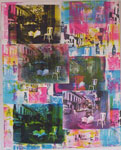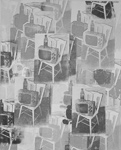 This Friday marks the opening of Adaptation to Evacuation: From NOLA to Iowa, a show of recent work by Karen Blomme at the Peanut Gallery in Rock Island. The exhibit showcases the transformation of Blomme's art over the course of two tumultuous years of study, reflection, migration, production, and adaptation.
This Friday marks the opening of Adaptation to Evacuation: From NOLA to Iowa, a show of recent work by Karen Blomme at the Peanut Gallery in Rock Island. The exhibit showcases the transformation of Blomme's art over the course of two tumultuous years of study, reflection, migration, production, and adaptation.
Knowing the underlying story of the last two years and then seeing how it manifests itself in the artist's work makes the show even more compelling. The initial idea for this artist/educator was to take a two-year sabbatical from Bettendorf High School (starting in fall 2004) and move to Louisiana to attend the University of New Orleans so she could earn her Master of Fine Arts degree.
When the radiator in her jeep blew out near Springfield, Illinois, within the first three hours of the initial move to New Orleans, that was the first sign that the "plan" might be subject to change. I'll just hit some of the highlights of Blomme's two-year quest by saying that the artist (and her husband) went through the process of relocating to NOLA (New Orleans, LA), and while there experienced an armed robbery and had a shooting outside of their home; a category-four hurricane blew through town a week after the shooting; four days later, they finally evacuated and re-relocated (to Davenport); she found a new school (the University of Iowa); and they re-re-relocated to a run-down apartment (in Iowa City) that was then hit by an F1 tornado less than nine months after the hurricane.
It almost became comical to see what else could be piled on Blomme's shoulders. Yet during all of those chaotic events, Blomme's artwork actually developed in a counter-intuitive direction (given her surrounding turmoil) by becoming simpler and more refined.
The almost obesely layered Chaos is an excellent technical and conceptual starting point for this journey of transformation. Chaos is the composite of at least three overlapping layers of silkscreen images. The color palette is mostly cool grays and some hints of earth tones that accentuate the flatness of the silkscreening process.
 There are fragments of outright recognizable images (such as a dog, a man, and a surfer dude) and possibly recognizable images, like some text and a face-like form, that struggle to separate themselves from the unyielding color masses with varying degrees of success.
There are fragments of outright recognizable images (such as a dog, a man, and a surfer dude) and possibly recognizable images, like some text and a face-like form, that struggle to separate themselves from the unyielding color masses with varying degrees of success.
While the visual turmoil within Chaos lives up to its name, it lacks the panache to be a satisfying chaos. Both an air-raid siren and a large symphonic orchestra can be loud, but the siren is merely loud, while the symphony can be an appropriate and satisfying loud.
Since it was created before Blomme's journey to New Orleans, Chaos serves as an important departure point for the rest of the work in the show. What is remarkable to witness is how the work becomes more simplified, distilled, and visually coherent even though events in and around the artist's life were anything but.
 The image simplification and solidification process can be initially be seen in Yellow NOLA, which is a nearly two-toned image of a maroonish-colored interpretative blend of New Orleans' architecture and cultural ambiance screened over a dynamic - and borderline obnoxious - safety-yellow base tone. The warm, flat darkness of the maroon simply allows the underlying yellow to ignite. The colors found in Chaos are co-habitating, while the colors in Yellow NOLA are having a torrid affair.
The image simplification and solidification process can be initially be seen in Yellow NOLA, which is a nearly two-toned image of a maroonish-colored interpretative blend of New Orleans' architecture and cultural ambiance screened over a dynamic - and borderline obnoxious - safety-yellow base tone. The warm, flat darkness of the maroon simply allows the underlying yellow to ignite. The colors found in Chaos are co-habitating, while the colors in Yellow NOLA are having a torrid affair.
Blomme's tenacious urge for visual play and exploration can be seen in Evacuate, which is the first within the series that utilizes a four-color screening process (CMYK, in which cyan, magenta, yellow, and black give the illusion of full-color instead of just four) to create photograph-like images to be distorted and accentuated by the artist to explore and chronicle the journey.
Breaking the image down into those four component colors allows Blomme the freedom to maintain her approach to image-making (layering multiple colors to construct the overall image) while bringing in greater spacial depth (which helps separate and distinguish the components).
Evacuate is composed of several partially overlapping color variations of a street in New Orleans. Although the trash bags on the corner were actually at the original location, the repeated image of the stark-white, empty wooden chair was inserted by the artist. The chair, which conjures feelings of comfort and relief, represents a small and very personal place/space. When the empty chair is ubiquitously scattered throughout the refuse-choked streets, it both visually and conceptually reinforces the notions of loss and displacement.
 The image Detach and the image Accumulate have nearly all the same ingredients at work. Their color palettes are nearly identical, and both show several images of a wooden chair occupied by a TV set. The simple relationship between the chair and the TV can signify several things simultaneously, such as owning a limited number of meager possessions or having the world of television occupy the physical and emotional space that a human normally would.
The image Detach and the image Accumulate have nearly all the same ingredients at work. Their color palettes are nearly identical, and both show several images of a wooden chair occupied by a TV set. The simple relationship between the chair and the TV can signify several things simultaneously, such as owning a limited number of meager possessions or having the world of television occupy the physical and emotional space that a human normally would.
But the repetitive linear images within Detach function as isolated entropic fragments, while the photographic images seen in Accumulate coalesce into a stunning gestalt product. Suddenly, the screened images have a compelling depth to them, and the geometric edges lend a simplifying structure to the images. Although there is certainly illusionary spacial depth within each image, the colors and placements of the various images cause the individual panels that form the image to recede and be thrust forward on the picture plane.
Some of her most recent works in the series have shifted away from the CMYK process and seem to be trying to find a visual way to reconcile with her earlier (less-spacial) image-making sensibilities.
Adaptation to Evacuation: From NOLA to Iowa opens this Friday as part of Gallery Hop and will run through July 22 at the Peanut Gallery, 300 21st Street in Rock Island. Rumor has it that some New Orleans influenced cuisine will also be a part of the opening, as well.










